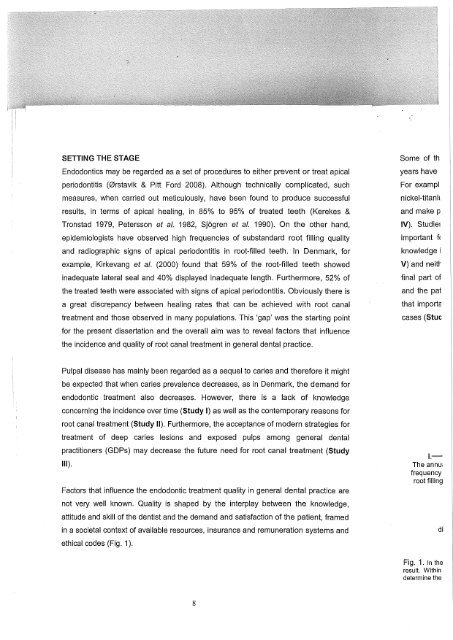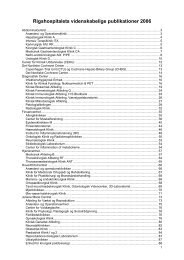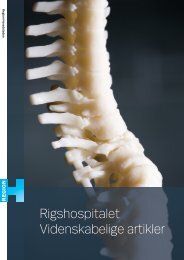View - CTU
View - CTU
View - CTU
Create successful ePaper yourself
Turn your PDF publications into a flip-book with our unique Google optimized e-Paper software.
SETTING THE STAGE<br />
Endodontics may be regarded as a set of procedures to either prevent or treat apical<br />
periodontitis (0rstavik & Pitt Ford 2008). Although technically complicated, such<br />
measures, when carried out meticulously, have been found to produce successful<br />
results, in terms of apical healing, in 85% to 95% of treated teeth (Kerekes &<br />
Tronstad 1979, Petersson et al. 1982, Sjogren et al. 1990). On the other hand,<br />
epidemiologists have observed high frequencies of substandard root filling quality<br />
and radiographic signs of apical periodontitis in root-filled teeth. In Denmark, for<br />
example, Kirkevang et al. (2000) found that 59% of the root-filled teeth showed<br />
inadequate lateral seal and 40% displayed inadequate length. Furthermore, 52% of<br />
the treated teeth were associated with signs of apical periodontitis. Obviously there is<br />
a great discrepancy between healing rates that can be achieved with root canal<br />
treatment and those observed in many populations. This 'gap' was the starting point<br />
for the present dissertation and the overall aim was to reveal factors that influence<br />
the incidence and quality of root canal treatment in general dental practice.<br />
Some of th<br />
years have<br />
For exampl<br />
nickel-titan it<br />
and make p<br />
IV). Studiei<br />
important f<<br />
knowledge i<br />
V) and neit~<br />
final part of<br />
and the pat<br />
that importa<br />
cases (Stuc<br />
Pulpal disease has mainly been regarded as a sequel to caries and therefore it might<br />
be expected that when caries prevalence decreases, as in Denmark, the demand for<br />
endodontic treatment also decreases. However, there is a lack of knowledge<br />
concerning the incidence over time (Study I) as well as the contemporary reasons for<br />
root canal treatment (Study II). Furthermore, the acceptance of modern strategies for<br />
treatment of deep caries lesions and exposed pulps among general dental<br />
practitioners (GDPs) may decrease the future need for root canal treatment (Study<br />
Ill).<br />
Factors that influence the endodontic treatment quality in general dental practice are<br />
not very well known. Quality is shaped by the interplay between the knowledge,<br />
attitude and skill of the dentist and the demand and satisfaction of the patient, framed<br />
in a societal context of available resources, insurance and remuneration systems and<br />
ethical codes (Fig. 1 ).<br />
I.<br />
The annu•<br />
frequency<br />
root filling<br />
di<br />
Fig. 1. In the<br />
result. Within<br />
determine the<br />
8








